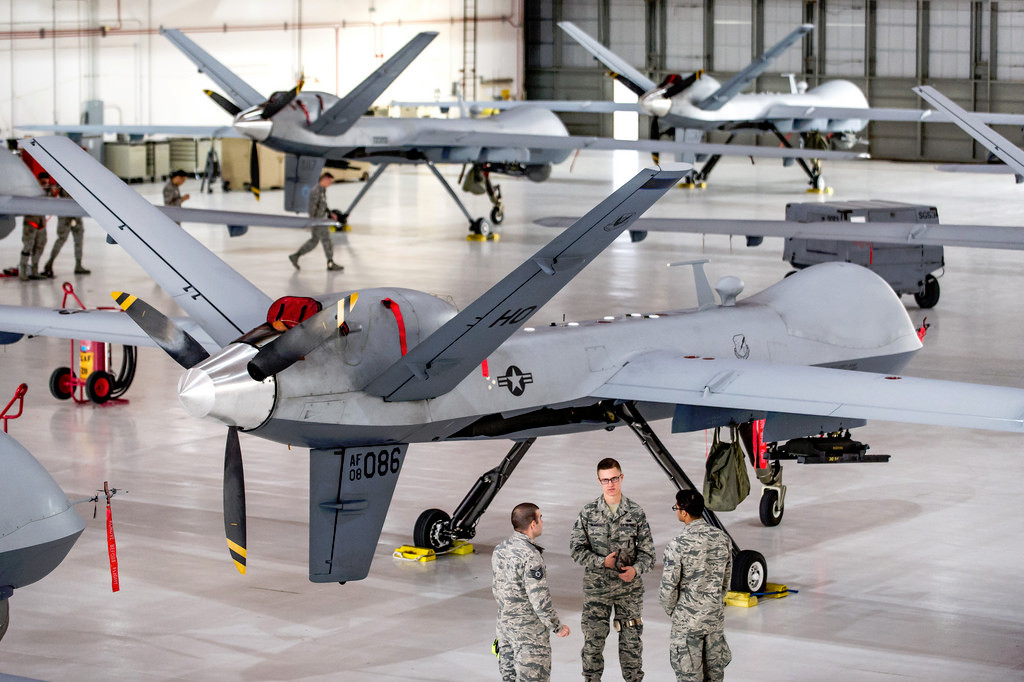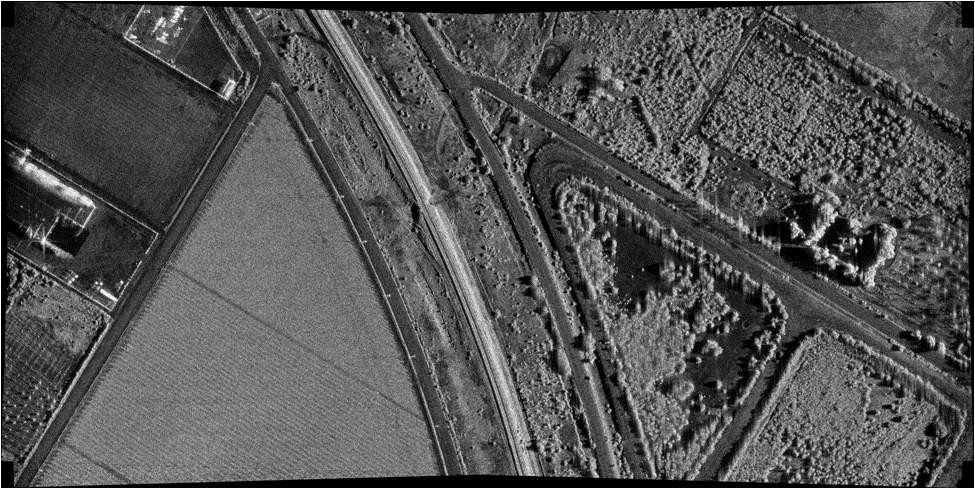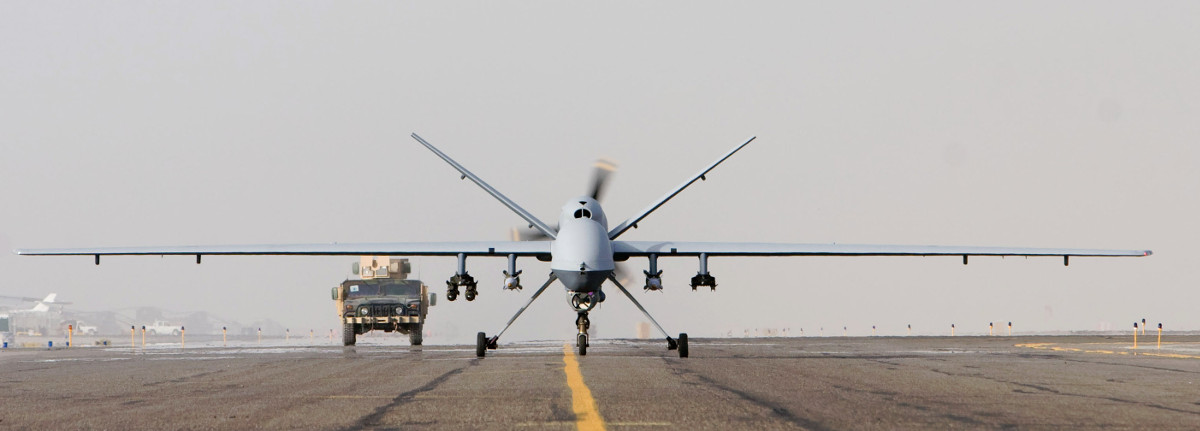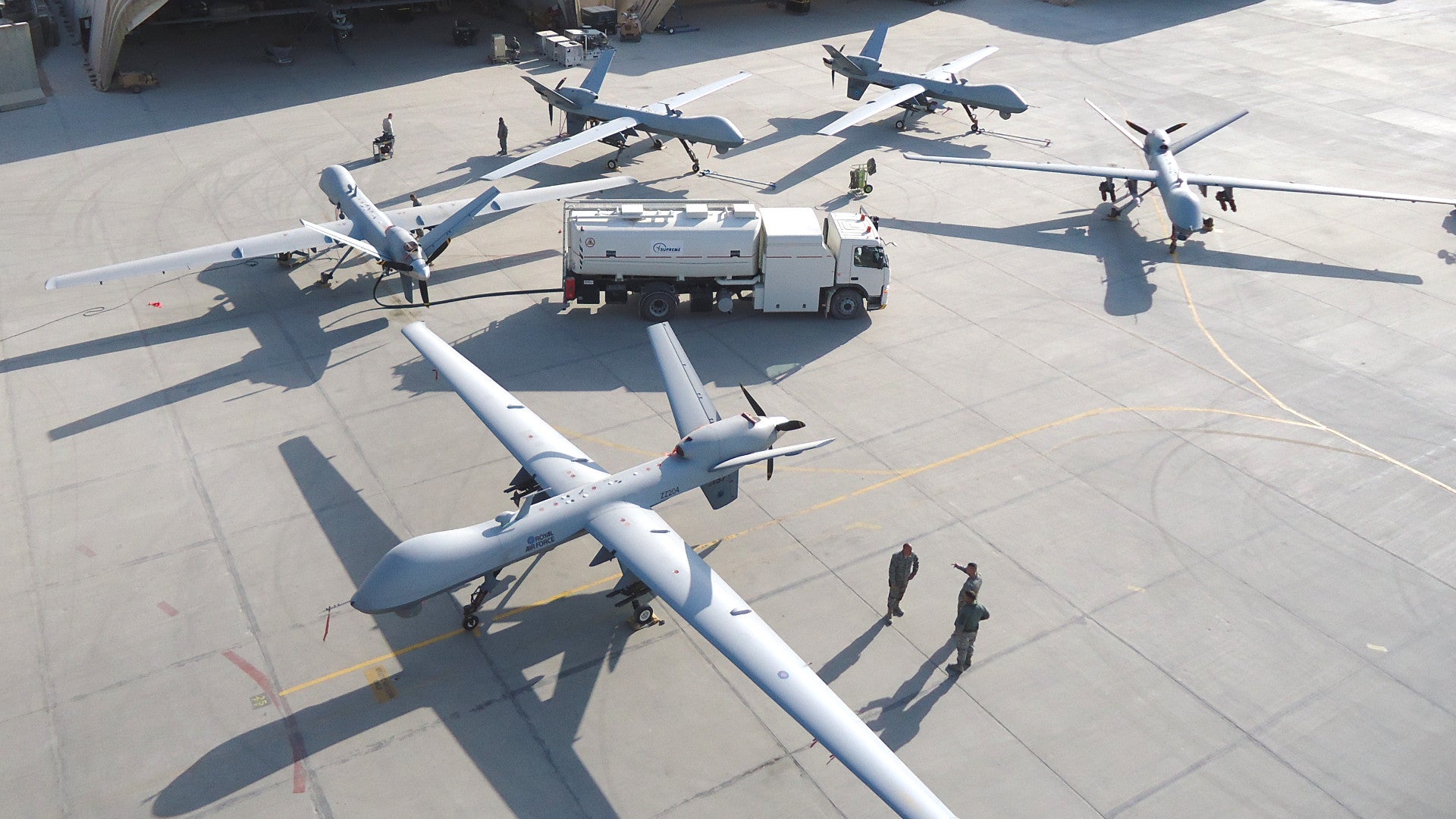The U.S. Navy is planning to hire drone-maker General Atomics to fly its own unarmed MQ-9 Reapers in support of U.S. Marines in Afghanistan. The service says the contractor-operated drones would provide a “surge” of intelligence, reconnaissance, and surveillance capabilities as the U.S. military expands its activities in the Central Asian country, which the U.S. Air Force is not able to provide at present.
On Jan. 9, 2018, the Naval Air Systems Command, or NAVAIR, announced the proposed deal on FedBizOps, the U.S. government’s main contracting website. The contract, which the Navy did not give an estimated value for, would cover up to a year of operations in Afghanistan running between the 2018 Fiscal Year, when began on Oct. 1, 2017, and the 2019 fiscal cycle.
The notice implies that this arrangement would be a sole-source contract the Navy would award directly to General Atomics without a lengthy competitive process. NAVAIR says “delaying the procurement” would be “impractical” given the urgent needs of Marines assigned to Task Force Southwest, which has the job of conducting advisory missions in Afghanistan’s infamous Helmand province, as well as portions of neighboring Nimroz province, both of which border Pakistan.
The contracting announcement doesn’t say how many Reapers would be involved in the contractor-run mission, or how many personnel it might take to manage the operation, which would not involve any armed sorties. The Navy did give very clear capabilities it was looking to procure, though.

As it stands now, NAVAIR is looking to hire General Atomics to provide a single “orbit” supplying coverage over one particular area 16 hours a day, seven days a week. The company could have to conduct missions lasting 24-hours or more in certain cases, but with advance notice.
A typical MQ-9 Reaper combat air patrol involves four individual aircraft, so that one aircraft is always on station, while another is heading back to base to refuel, and a third is heading out to take over the mission. The fourth drone is in reserve in case a malfunction, accident, or other issue sidelines one of the aircraft.
In order to make this work smoothly, the Navy proposed a so-called “remote-split” arrangement, whereby General Atomics’ crews would launch and recover the drones in Afghanistan using line-of-sight control, but pilots and sensor operators would perform the actual operations from a site in the United States via satellite link. The team in Afghanistan would also be in charge of maintaining the aircraft and their sensors. The U.S. Air Force already uses this method to conduct unmanned persistent surveillance operations in Afghanistan and elsewhere around the world.
In addition, the Navy says the Reapers themselves must carry a high-resolution imaging radar system, as well as a multi-spectral camera system. The Air Force’s latest MQ-9s already carry the Raytheon multi-spectral targeting system and General Atomics’ own Lynx multi-mode radar and it’s likely this is the capability NAVAIR is looking for on the contractor-operated drones. There is no stated requirement for a wide-area persistent surveillance system with multiple cameras, which could be particularly useful for monitoring insurgent movements.

Separate from the actual business of operating the drones, the proposed Navy contract would also require General Atomics to provide liaisons in Task Force Southwest’s command center and other headquarters in order to aid in the sharing of data the unmanned aircraft gather during their flights. The goal is to make sure Marine intelligence elements and their troops on the ground in Afghanistan receive the information in a timely manner, which could be especially important for assisting in Afghan or other coalition operations against fleeting, time sensitive targets, such as small groups of insurgents or terrorists on the move or particular individuals.
This entire proposed arrangement is significant, but not necessarily unprecedented. Stretched increasingly thin on various counter-terrorism related efforts around the world, the U.S. military has increasingly relied on contractors to provide aerial intelligence, surveillance, and reconnaissance support, among various other capabilities.
In Afghanistan in particular, the U.S. military has routinely hired private companies to fly manned spy planes with a variety of different sensor suites. In August 2017, the U.S. Army announced it would again look to extend the contract for a pair of contractor-owned and operated Night Eagle aircraft. These are modified Beechcraft King Airs carrying sensor turrets with both electro-optical and infrared full-motion video cameras, which can also capture still images to help spot any significant changes over time.

Since at least 2015, the U.S. Air Force itself has employed contractors to fly unarmed drones in intelligence gathering missions. The service pursued the controversial decision as it struggle in meeting the growing demands for the support, which had already put a serious strain on existing unmanned aircraft pilots and sensor operators. Contractors already operate smaller drones, such as the ScanEagle, within Afghanistan.
But that the Navy is looking to hire General Atomics directly to supplement Air Force drone operations in Afghanistan speaks to a number of continuing concerns about both the prosecution of that conflict and the present state of the U.S. military. President Donald Trump and his administration have made securing a victory against the Taliban and other militants and terrorists in the country a central policy.
As such, there has been a renewed emphasis on American involvement in Afghanistan, including the Marine task force headquartered in Helmand, and a steady increase in the U.S. military presence in the country. This in turn has created requirements for more air strikes, close air support, and aerial intelligence, surveillance, and reconnaissance.
“I have served as a battalion commander in Iraq and regimental commander in Afghanistan, but in some ways, the Task Force Southwest mission has been the most complex challenge I have faced,” U.S. Marine Corps Brigadier General Roger Turner, head of the task force, told Marine Corps Times earlier in January 2018. “Even though we don’t have Marines directly maneuvering against the enemy, we are most certainly fighting the enemy by, with and through our [Afghan National Defense and Security Force] partners.”

Persistent surveillance has been essential for limiting the ability of the Taliban and other groups to move freely, especially at night, and had been essential to keep militants from making significant gain. At the same time, as we at The War Zone have noted
on multiple occasions, the Afghans still cannot adequately provide this and other critical capabilities on their own. So, the NATO-led coalition, and the U.S. military in particular, remain responsible for the bulk of air support activities in the country broadly.
The U.S. Air Force, though, has been increasingly hard pressed to provide much of this support, including additional drone patrols. The demands of a seemingly never-ending world-wide war on terrorism have put increasing strain on the service after nearly two decades of almost constant operations.
Earlier in January 2018, a report by Air Force Times gave new and particularly granular detail to the difficulties the Air Force faces in support operations around the globe. Worrisome personnel shortages have now expanded from the unmanned community into manned aircraft operations, as well. Monetary bonuses and other incentives have so far failed to fully stem the exodus of pilots in particular.
The official video below, titled “Insatiable Demand,” which the Air Force released in April 2017, gives a look into the existing demands on the Air Force’s drone community.

The increasing tempo of air strikes and other aerial operations in Afghanistan will likely cut into any respite the Air Force may have gained from a slow-down in operations over Iraq and Syria. The most notable of these efforts has been a series of high profile attacks on infrastructure related to the production of heroin and other illicit narcotics.
Along the border with Pakistan, in provinces such as Helmand and Nimroz, the need for more air support, especially intelligence gathering sorties, may only increase as the Trump Administration seeks to pressure the Pakistani government into doing more to combat Taliban and other terrorist activities on their side of the border and stem cross-border movement by withholding some military and security-related aid. So far, though, authorities in Islamabad have threatened to end coordination with the US military and could consider cutting off over-land supply lines critical to coalition forces in Afghanistan in response.
NAVAIR’s proposed contract with General Atomics seems to be further admission that the Air Force simply cannot meet all of the demands the U.S. military has placed on it, especially as the United States steps up operations in Afghanistan again. It’s not clear when that might change, either.
The service is also planning to finally retire the MQ-1 Predator for good by the end of 2018 in favor of the MQ-9. It remains unclear what will happen to the older, less capable drones, but one possibility is that contractors could scoop them up and put them back into action as part of future contractor-managed deals. However, NAVAIR’s January 2018 notice specifically stated a requirement for Reapers.

The Trump Administration has promised significant budget increases and a larger U.S. military overall, but that failed to materialize in the budget for the 2018 fiscal cycle. It is possible that we may see this spending boost when the White House releases its Fiscal Year 2019 in the coming months.
How long it might take for the new funding to make an impact is unclear. Congress would still have to approve the money for any such budget, too.
Legislators have so far been able to unable to get together to actually fund the budget, formally known as the 2018 National Defense Authorization Act, even after Trump signed it into law late in 2017. Instead, they have kept the government functioning using short-term spending bills, known as continuing resolutions. Secretary of Defense James Mattis, among other senior U.S. military leaders, has decried this mechanism, which effectively prevents budget long-term planning.
Of course, these issues don’t change the needs of deploy units and NAVAIR seems intent on getting Marines Helmand drone support sooner rather than later. Unless the budget situation changes dramatically or the United States finds a way to significantly reduce its commitments overseas, it seems likely we’ll see more of these contracts, at least in the near term.
Contact the author: joe@thedrive.com
